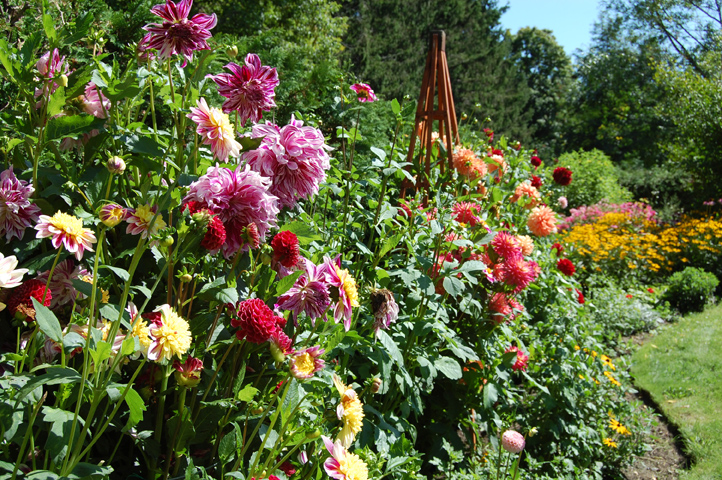Sister Sue’s Dahlia Inspiration
Dahlias are often considered a warm climate plant – heck it’s Mexico’s national flower! Being native to Mexico, Colombia, and Central America, the plant certainly developed a love of the warmer things in life. A life that most Colombians would not agree living in Canada is. But hey, our summers are warm enough and with a little extra care, dahlias can be grown successfully here. Just ask my sister, Sue. She grows hundreds of them every year.
It’s definitely too late this year to start them but think about it for next year. They really are beautiful plants, well worth the extra effort, in my opinion. And there are so many varieties to choose from.
Growing Requirements
I’ll make this short and sweet. Full sun (6 hours minimum), well-drained soil (sand or loam), and a a slightly acidic pH (about 6.5).
Planting Out Tubers
Do this only after the soil has warmed up. Here in Toronto, I usually put them out at the beginning of June. By then, the ground is warm and not too moist from the snow melt and spring rains so tubers won’t be subject to rot.
The direction you place them in the ground matters. After digging a hole just a bit bigger than the tuber itself and about 6 inches deep, make sure the tuber sits with its ‘eyes’ facing up. Your dahlia will benefit from a bit of compost at the bottom of the hole as well. When your dahlia is sitting below ground, its crown should be just above or level with the soil after the hole is filled back in.
Unlike with most plants, you will not water the tuber after you have planted it. Rot can set in very quickly since the tuber cannot make use of the extra water and it will settle in the open pores of the recently disturbed soil. The late spring/early summer rains will be enough to awaken the dahlia bulb.
Staking
It depends on the type of dahlia you are growing, but medium to tall dahlias will definitely need staking or it will take no more than one good rain for them to topple over. The blooms are heavy and become much heavier when a good rainstorm fills their blooms with water.
Consider a pigtail stake for this project or for taller dahlias, even the spiral stakes will work very well.
When I plant my tubers, I generally put the stake in when it’s young to avoid piercing damaging the plant. You can also place it beside the tuber after planting to remind yourself where you’ve placed it.
After The Plant Starts to Grow
Once you see green starting to pop out of the soil (about 2 months after planting), you will want to water. Slow, deep waterings every few days (when it’s not raining, of course) are beneficial during this rapid time of growth.
As your plant gets taller, make sure the stake is providing adequate support right up the stem.
Use a compost tea every other time you water or fertilize according to whichever product you decided to go with (I personally like using Green Earth’s Rose, Annual, and Perennial fertilizer). It’s important not to overfertilize and don’t fertilize too far into the fall. I usually stop at the beginning of September.
Enjoying Your Blooms
Dahlia blooms last quite a long time and more than likely, if the plant is getting enough sun, multiple blooms will come from one plant. Enjoy them! Cut them! Photograph them! After the first frost, the entire plant will turn black and wither away.
But don’t despair, digging the tubers and storing them over winter will allow you to replant them next year. Check out my blog on the very subject.
While you’re at it, check out my dahlia video as well for some extra information.






